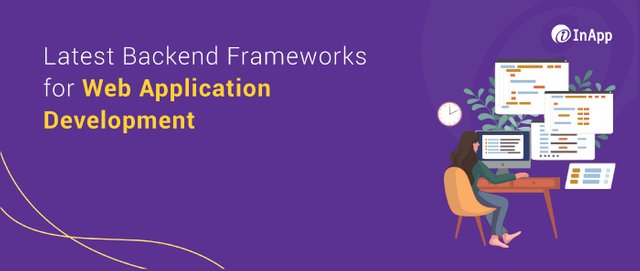Latest Backend Frameworks for Web Application Development

Backend frameworks can streamline web application development with standardized codes, configurations, and tools. By systemizing the programming process, backend frameworks make it faster and easier to implement key web application components like user authorization, security, privacy encryptions, database management, and more.
Frameworks are full-stack applications that include almost all the functionality needed to create a web application. Users don’t interact directly with server-side frameworks because they work behind the scenes of a website. However, they will notice how well a web application functions, which a backend framework can strengthen.
For developers, backend frameworks can make the coding and maintenance process much faster, as well as reduce the potential for bugs and other errors. Let’s learn more about the latest backend frameworks for web application development projects.
Different Types of Web Frameworks
Backend frameworks incorporate all of the different building blocks of a web application, such as HTTP requests, templating, routing, and database object-relational mappers (ORMs). The architecture of a framework defines the relation between its components, such as…
- Model-View-Controller (MVC): MVC models are used for developing a user interface (UI) with three interconnected elements to separate internal representations of information from the ways information is presented to and accepted by the user.
- Model-View-View Model (MVVM): In MVVM, the view layer acts as a controller and converts the data objects from the model layer into manageable components. The view layer handles all the user requests directly, so the data binding is more straightforward.
- Push-based: Push-based architecture adopts actions that do the necessary processing and then pushes the data to a view layer to furnish the outcome.
- Pull-based: Also called component-based, a pull-based framework starts with the view layer, which in turn can pull outcomes from diverse controllers as required.
- Three-tiered: Comprises three physical tiers — the presentation tier, or user interface; the application tier, where data is processed; and the data tier, where the data associated with the application is stored and managed. Because each tier runs on its own infrastructure, it can be developed simultaneously by a separate development team and can be updated or scaled as needed without impacting the other tiers.
Features and Benefits of the Most Popular Backend Frameworks
Choosing the right backend framework will depend on the needs of your specific project. Here are some of the most common ones.
Ruby on Rails
Ruby on Rails, also known as Rails or RoR, is an open-source framework used by well-known companies like Apple, Hulu, Github, Spotify, and Airbnb. This MVC full-stack framework is almost 20 years old, but it remains a top framework because of its intuitiveness, strong developer community, and a plethora of tools.
Django
One of the most popular Python web frameworks, Django includes dozens of extras to handle common web development tasks. This framework streamlines user authentication, content administration, site maps, RSS feeds, and many more tasks. Django also helps to prevent security issues like SQL injection, cross-site scripting, cross-site request forgery, and clickjacking.
Express JS
Express is a minimal and flexible Node.js web application framework with a robust set of features for web and mobile applications. Developers can create robust APIs with a variety of HTTP utility methods and middleware. Express provides a thin layer of fundamental web application features, without obscuring Node.js features.
Flask
This Python framework is classified as a microframework because it does not require particular tools or libraries. Extensions exist for object-relational mappers, form validation, upload handling, various open authentication technologies, and several common framework-related tools. Popular applications that use the Flask framework include Pinterest and LinkedIn.
Gin Gonic
Gin is a web framework written in Golang. Gin Gonic is particularly useful for developers looking for better performance. It reportedly features a Martini-like API that’s up to 40 times faster. It also has a huge community, extensive code coverage(~ 98%), and comparatively fewer issues than some other backend frameworks.
Laravel
Laravel is a free and open-source PHP web framework following the MVC architectural pattern and based on Symfony. Laravel features include a modular packaging system with a dedicated dependency manager, different ways for accessing relational databases, and utilities that aid in application deployment and maintenance.
CodeIgniter
CodeIgniter is an open-source framework used for building dynamic websites with PHP. CodeIgniter is loosely based on the MVC architecture. While controller classes are a necessary part of development under CodeIgniter, models and views are optional. CodeIgniter is most often noted for its speed when compared to other PHP frameworks.
CakePHP
CakePHP also is an open-source framework that follows the MVC approach and is written in PHP. Modeled after engineering concepts similar to Ruby on Rails, CakePHP uses well-known software design premises, such as convention over configuration, active record, association data mapping, and front controller.
The Bottomline
The right backend framework can speed up the development process. We recommend working with an experienced software development team to find the ideal framework for your web application.
InApp’s backend development engineers have the technical experience you need for high-quality web applications, including databases, backend logic, APIs, and servers. Contact us to learn how we can help your web application development project succeed.







